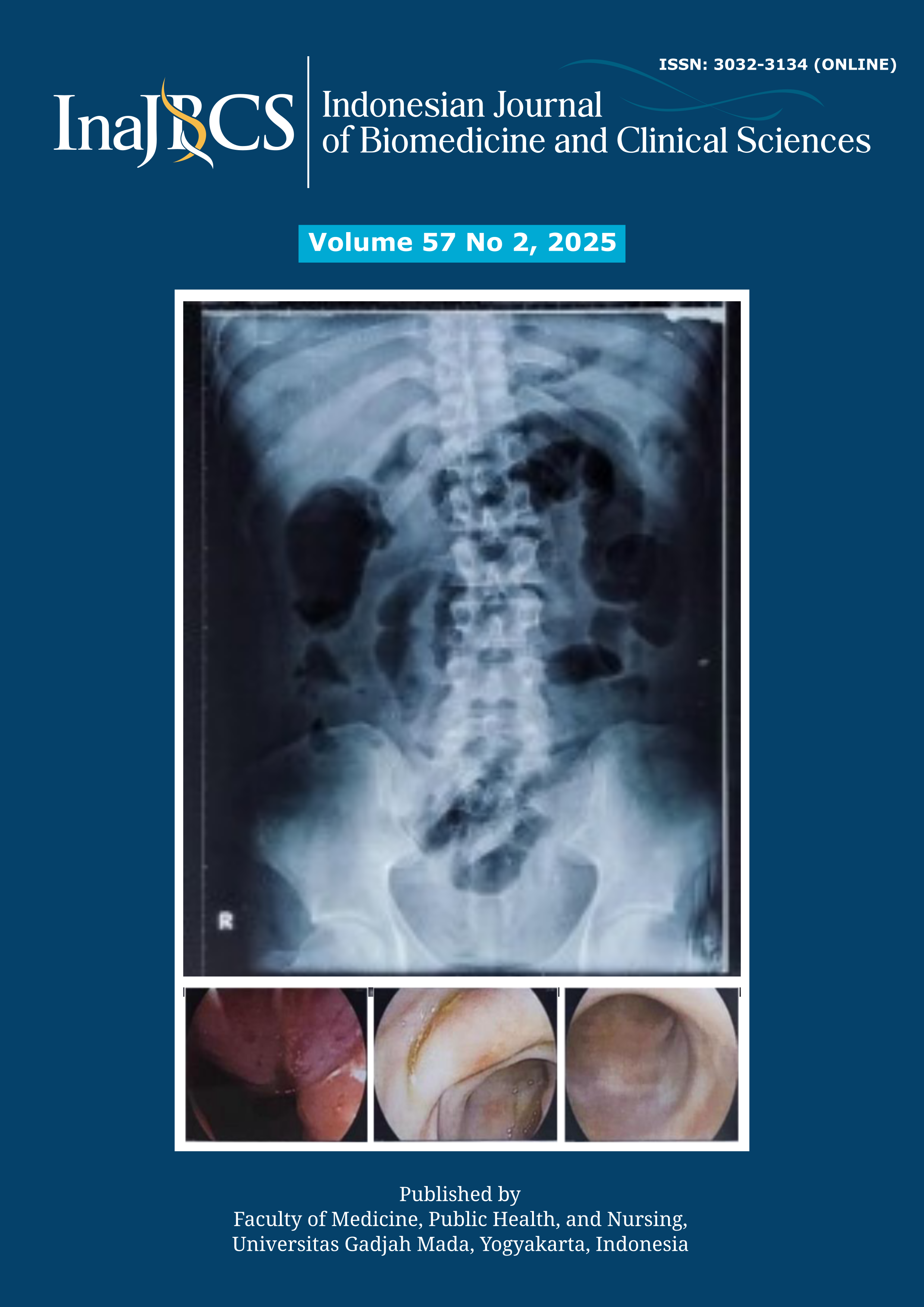The role of bisphosphonate and bone morphogenetic proteins in congenital pseudoarthrosis of the tibia management: a literature review
Abstract
Congenital pseudoarthrosis of the tibia (CPT) is a rare medical condition characterized by a congenital absence of union in the tibia, which causes the leg to flex anterolaterally. Despite the use of several surgical techniques for the treatment of CPT, there is still a significant risk of failure with surgical interventions. Recent studies have shown that bisphosphonates (BP) and bone morphogenetic proteins (BMP) can be effective adjuncts to surgical procedures, increasing the success rate of bone union and reducing the chance of re-fracture. This review aimed to evaluate the role of BP and BMP in CPT. In this review, a comprehensive literature evaluation was conducted using the PRISMA method. The databases used to search for information included PubMed, ScienceDirect, and Google Scholar for the past 10 years. Six articles were included in this review. The results showed that using pharmacological agents such as BMP and BP is considered safe for pediatric patients as an adjunctive treatment to surgery. This combination can effectively increase the speed of bone union and prevent re-fractures. The small sample size, different protocols, and different doses may have impacted the study results, which should be thoroughly explained.
References
Bayusentono S, Brevi Putri T. Congenital pseudoarthrosis tibia in child with neurofibromatosis type 1 treated with the combined vascularized fibular graft and elastic stable intramedullary nail (Esin). J Orthop Traumatol Surabaya 2020; 9(22):
https://doi.org/10.20473/joints.v9i1.2020.22-28
Agrawal U, Vivek T. Congenital tibial pseudarthrosis. StatPearls. in NCBI Bookshelf 2022. 1-30.
Hissnauer TN, Stiel N, Babin K, Rupprecht M, Hoffmann M, Rueger JM, et al. Bone morphogenetic protein-2 for the treatment of congenital pseudarthrosis of the tibia or persistent tibial nonunion in children and adolescents: A retrospective study with a minimum 2-year follow-up. J Mater Sci Mater Med 2017; 28(4):60.
https://doi.org/10.1007/s10856-017-5868-9
Patil SN, Rao PS, Yalamanchili RK. Residual nonunion in a case of two and a-half year old child congenital pseudarthrosis of ipsilateral tibia and fibula treated by intramedullary fixation with k-wire and allogenic cancellous strut graft: a case report. Int J Med Res Heal Sci 2013; 2(2):284-9.
https://doi.org/10.5958/j.2319-5886.2.2.011
Khan T, Joseph B. Controversies in the management of congenital pseudarthrosis of the tibia and fibula. Bone Joint J 2013; 95-B(8):1027-34.
https://doi.org/10.1302/0301-620X.95B8.31434
Shah H, Rousset M, Canavese F. Congenital pseudarthrosis of the tibia: management and complications. Indian J Orthop 2012; 46(6):616-26.
https://doi.org/10.4103/0019-5413.104184
Laufer A, Fromer A, Gosheger G, Roedl R, Schiedel F, Broeking JN, et al. Reconstructive approaches in surgical management of congenital pseudarthrosis of the tibia. J Clin Med 2020; 9(12):4132.
https://doi.org/10.3390/jcm9124132
Paley D. Congenital pseudarthrosis of the tibia: combined pharmacologic and surgical treatment using biphosphonate intravenous infusion and bone morphogenic protein with periosteal and cancellous autogenous bone grafting, tibio-fibular cross union, intramedullary. Bone Grafting 2012.
Birke O, Schindeler A, Ramachandran M, Cowell CT, Munns CF, Bellemore M, et al. Preliminary experience with the combined use of recombinant bone morphogenetic protein and bisphosphonates in the treatment of congenital pseudarthrosis of the tibia. J Child Orthop 2010; 4(10):507-17.
https://doi.org/10.1007/s11832-010-0293-3
Pannier S. Congenital pseudarthrosis of the tibia. Orthop Traumatol Surg Res 2011; 97(7):750-61.
https://doi.org/10.1016/j.otsr.2011.09.001
Paley D. Congenital pseudarthrosis of the tibia: biological and biomechanical considerations to achieve union and prevent refracture. J Child Orthop 2019; 13(2):120-33.
https://doi.org/ 10.1302/1863-2548.13.180147
Fabeck L, Ghafil D, Gerroudj M, Baillon R, Delincée P. Bone morphogenetic protein 7 in treating congenital pseudarthrosis of the tibia. J Bone Joint Surg Br 2006; 88(1):116-8.
https://doi.org/ 10.1302/0301-620X.88B1.16619
Lee FYI, Sinicropi SM, Lee FS, Vitale MG, Roye DP, Choi IH. Treatment of congenital pseudarthrosis of the tibia with recombinant human bone morphogenetic protein-7 (rhBMP-7). A report of five cases. J Bone Jointt Surg Am 2006; 88(3):627-33.
https://doi.org/10.2106/JBJS.D.02201
Bobyn J, Rasch A, Kathy M, Little DG, Schindeler A. Maximizing bone formation in posterior spine fusion using rhBMP-2 and zoledronic acid in wild type and NF1 deficient mice. J Orthop Res 2014; 32(8):1090-4.
https://doi.org/10.1002/jor.22628
Das SP, Ganesh S, Pradhan S, Singh D, Mohanty RN. Effectiveness of recombinant human bone morphogenetic protein-7 in the management of congenital pseudoarthrosis of the tibia: A randomised controlled trial. Int Orthop 2014; 38(9):1987-92.
https://doi.org/10.1007/s00264-014-2361-7
El-Hoss J, Chong T, Carpenter EC, Sullivan K, Deo N, Mikulec K, et al. A combination of rhBMP-2 (recombinant human Bone Morphogenetic Protein-2) and MEK (MAP kinase/ERK kinase) inhibitor PD0325901 increases bone formation in a murine model of neurofibromatosis type I pseudarthrosis. J Bone Joint Surg Am 2014; 96(4):e117.
https://doi.org/10.2106/JBJS.M.00862
Papanna MC, Saldanha KA, Kurian B, Fernandes JA, Jones S. The use of recombinant morphogenic protein-2(rhBMP-2) in children undergoing revision surgery for persistent non-union. Strategies Trauma Limb Reconstr 2016; 11(1):53-8.
https://doi.org/10.1007/s11751-016-0251-9
Deo N, Cheng TL, Mikulec K, Peacock L, Little DG, Schindeler A, et al. Improved union and bone strength in a mouse model of NF1 pseudarthrosis treated with recombinant human bone morphogenetic protein-2 and zoledronic acid. J Orthop Res 2018; 36(3):930-6.
https://doi.org/10.1002/jor.23672
Shannon CE, Huser AJ, Paley D. Cross-union surgery for congenital pseudarthrosis of the tibia. Children 2021; 8(7):547.
https://doi.org/10.3390/children8070547
Taqwin, Sumiaty, Lasman K. Penyuluhan, pengetahuan dan sikap pasangan usia subur tentang inspeksi visual asam asetat (IVA) di Kelurahan Birobuli. Poltekita J Ilmu Kesehat 2018; 12(1):8-14.
Wulandari FI, Susanti LW. Peningkatan sikap wanita usia subur tentang iva test melalui penyuluhan kesehatan. Infokes J Ilm Rekam Medis dan Inform Kesehat 2018; 8:16-20.
Butler RJ, Marchesi S, Royer T, Davis IS. The effect of a subject-specific amount of lateral wedge on knee mechanics in patients with medial knee osteoarthritis. J Orthop Res Sept 2007; 25(9):1121-7.
https://doi.org/10.1002/jor.20423
Richards BS, Oentgen ME, Johnston CE. The use of rhBMP-2 for the treatment of congenital pseudarthrosis of the tibia: a case series. J Bone Joint Surg Am 2010; 92(1):177-85.
https://doi.org/10.2106/JBJS.H.01667
Carlier A, Geris L, Gastel NV, Carmeliet G, Oosterwyck HV. Oxygen as a critical determinant of bone fracture healing-A multiscale model. J Theor Biol 2015; 365:247-64.
https://doi.org/10.1016/j.jtbi.2014.10.012
Cho TJ, Seo JB, Lee HR, Yoo WJ, Chung CY, Choi IH. Biologic characteristics of fibrous hamartoma from congenital pseudarthrosis of the tibia associated with neurofibromatosis type 1. J Bone Joint Surg Am 2008; 90(12):2735-44.






